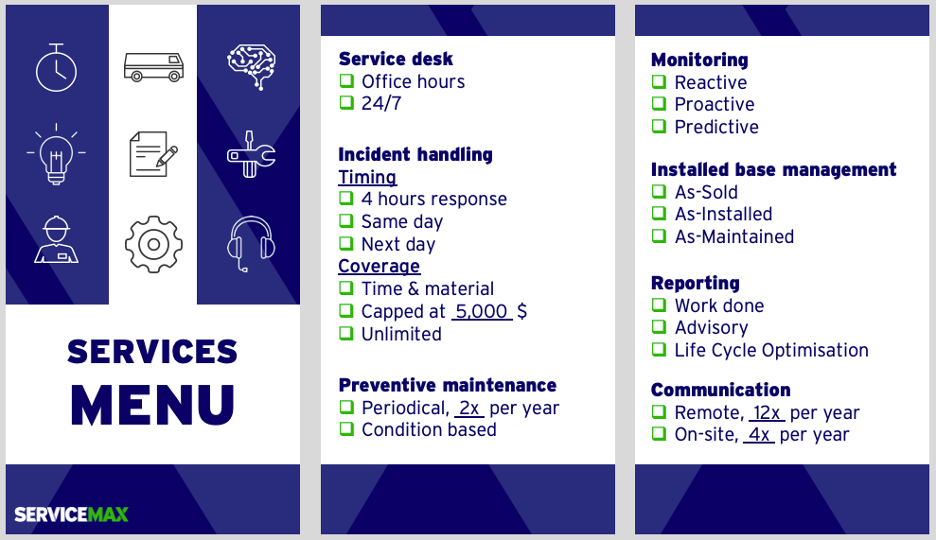If a product requires a physical repair there are two options: a technician goes to the product or the product comes to the technician. Whatever model is used depends on many different parameters. The good news, with modern service execution tools your options grow exponentially while maintaining control.
Covid is adding an additional boost to the uplift of depot repair. If technicians are not welcome on the site of installation, then the assets, or part of it, have to come to a depot.
A balanced choice
It would be nice if the repair model could be a choice. A choice based on situational characteristics, instead of rock solid process defaults.
Why choice? Because more vocal and demanding customers expect and request choice. Situational, because the conditions can be different each time to both requestor and provider. By giving choice you provide a level of autonomy to the recipient. Choice is double edged as well. The receiver has to process choice and thus you can get valuable information on what is important to that person. Again, what is important, changes over time and is situational.
Multiple service delivery options
To put field service and depot service in a perspective, I want to paint the wider picture of service delivery options.
In this picture the cheapest mode of service delivery is the self healing variant. Though cheap from a service delivery point of view, it may be expensive from a product engineering point perspective.
On the other end of the spectrum we have the dual-visit engineer on site variant. If the failure is hard to diagnose, you need a trained engineer to find the problem and define the mitigating action plan. If the spectrum of potential solutions is wide, it is likely you are not carrying all spare parts and tools resulting in a second visit for the fix.
Note: not depicted in the landscape is the NPS/ CSAT element of all these service delivery options. It is in the entitlement process that you weigh the business objectives and select the best option for that service instance.
Design for Service
The various service delivery options are very much tied to the way your products are designed. We all know the example of the owners manual of a car. The manual defines the maintenance guidelines based on a generic use profile. The setup of the service delivery in car dealerships is based on that manual. In short, the simple things are customer replaceable[1], some repairs can be done in the field, whereas others can only be done in a fully equipped depot.
A similar setup applies to the maintenance manual of capital goods. If the capital good itself is non-moveable, then it becomes even more important to design for service. It is unlikely one will deinstall an MRI to send it to a depot. It is also unlikely the technician will carry an unlimited amount of spare parts, tools and calibration equipment. Thus the manual prescribes which ‘nodes’ in the bill-of-material are fixed on-site and which ones will be swapped and sent to a depot.
The rise of depot repair
If technician capacity is scarce. If technician capacity is expensive. If customers want more uptime and faster repairs. Then it is logical that a service organisation moves from lower level component on-site repair to higher level sub-assembly swap. The effort and complexity of repairing the sub-assembly is moved from on-site to depot. As a result you can do more repairs with the same pool of technicians … and even use lesser skilled technicians.
“I used to pay 5$ for a component and 80$ for 1 hour of technician time, now I pay for a 200$ subassembly and 15 minutes of swap time”
And what is the advantage for the asset owner? It is more than only comparing the material and labour cost. You get a faster fix, alias more uptime. The new sub-assembly is fully tested and comes with warranty, alias you get better quality at lower risk. One more benefit. If the sub-assembly swap requires lesser technology skills from the technician, what if the swap could be performed by yourself? This gives you more freedom and flexibility to source those sub-assemblies.
Whether the depot model is charged as part of a full service contract or time-and-material, the value promise presents itself beyond the individual repair action. More-over, the value appraisal will be dependent on the weighing of cost & benefit factors fro both the service organisation and the asset owner.
Enabling and invoking depot repair
To facilitate a depot-model you need business process support that manages :
- reverse logistics of the sub-assembly from customer to depot
- facilitates the actual repair/ refurbishment of the unit in the depot
- triggers forward logistics to get the sub-assembly back to the customer
Depending on your commercial offering, you may want to add additional features like:
- provide a loaner while sub-assembly is in depot or
- offer an advance exchange so only one on-site intervention is required and the refurbished unit ends up in inventory.
And maybe most important of all is getting decision-making support when to and when not to invoke of depot repair. This ties to your entitlement process and how you weigh your business objectives when your vocal customer is calling.
With modern service execution tools it’s all about connecting the dots. Using available information from Customer, Workforce and Asset to present choice to both the asset owner and the service provider.
[1] Some of you may be familiar with acronyms FRU & CRU (Field Repairable Unit and Customer Replaceble Unit). If we had to give an acronym to the depot variant, it would be called DRU.











